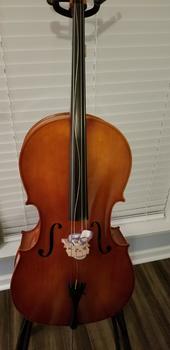
Sudden Floppy String Syndrome has hit several members of my studio. They have come in with cellos that have completely de-tuned themselves in the case, on the stand, and sometimes right before their eyes. Many times the strings are so loose that they are hanging off the cello! Pleas for help via text, huge chunks of lesson time devoted to tuning, frustration about not having been able to practice, and even feelings of guilt--all of these are signs that the season of SFSS is upon us, and cellists everywhere are suffering.
You may be thinking: What causes it and what can we do to prevent it from happening to us?
I will answer these questions below and provide instructions for making a little gadget that can help end the threat of SFSS forever!
But first, a quick story.
Moisture, Gone With The Wind
 Wood cells
Wood cells Luckily I was able to get it fixed, but ever since that night I have been haunted by the knowledge of the power of dry air.
Your cello will most likely lose moisture from time to time, no matter how hard you try. But what we need to prevent is the drastic and sudden loss of moisture. That's the real crack-maker...
...and the cause of SFSS!
To explain, let's apply the wood-drying scenario to your pegs:
The pegs are made of ebony, which is a type of wood. When this wood dries out, the pegs become skinnier. The cells of the wood of the peg box will shrink too. So the peg hole gets bigger, the peg gets smaller, and the whole system loses the friction that it needs to stick in place and hold the string in tune. So it comes loose and the string unravels. Sometimes all the way. And sometimes all of the strings at once!
When my students have experienced this, the sound post has managed to stay in place most of the time (thank goodness, since I can't fix that in a lesson!), so it's just a matter of tuning the cello back up with the pegs.
But how can we prevent this from happening?
The answer is simple: HUMIDIFIERS!
Commercial Humidifiers
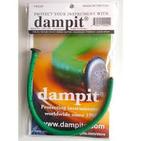
I won't go into all the pros and cons-- especially since I think you can make one yourself that will be even better--but I will tell you that Stephanie Voss at Voss Violins no longer recommends Dampits since they can damage the wood when used improperly (which happens a lot).
DIY Humidifiers
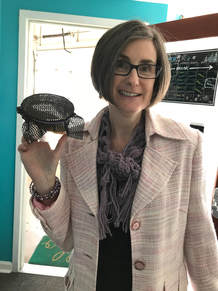 Mimi with her homemade humidifier
Mimi with her homemade humidifier That really got me thinking about DIY humidifiers.
I remember my first encounter with with a homemade humidifier was years ago. My teacher cut two short sections from an ice cube tray, nestled little, damp, ice-cube-sized sponge pieces in the ice cube depressions, and placed the whole unit in each c-bout while her cello rested in its case. She didn't move the case while these were in it, since the trays and sponges would rattle around loose in the case.
| That had gotten me thinking about how to make my own humidifier, one that could stay in the case when you moved it. I decided to try my hand at it, and this first version was fun to make. I drilled holes in bar-soap travel cases, filled them with cut-to-size sponges, and secured them with rubber bands. I gave a few of them away to students and eventually ended up buying a manufactured humidifier for my case. But I can honestly say, I think the DIY versions are just as good! |
Make Your Own in 6 Easy Steps
Update: Mimi strikes again!
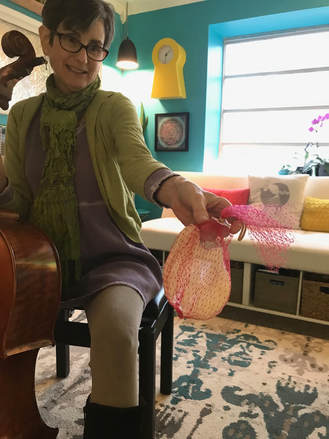
Mimi came to her lesson just last week with a peculiar bag hanging from a peg.
It was another humidifier!
This time, it's a version that can be nearer to the pegs (even better to prevent SFSS!) and is even easier to make.
Just stuff a few damp paper towels into a fruit bag and hang it from a peg.
That's it.
This is perfect humidifier for those of you who prefer your cello to live outside the case when you aren't playing it.
Thanks, Mimi, for these great ideas!
Blue Sky, Gonna Cry
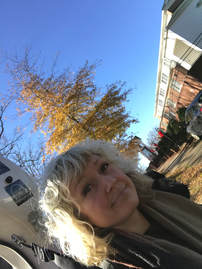 On the way to a gig, noticing danger
On the way to a gig, noticing danger Even if the sky isn't so blue, the heat in your house can dry out your cello too. Besides making or buying a humidifier, you should keep your cello in the case (unless you need it to stay on a stand to promote practicing) and keep it away from any doors, windows, or air registers in your house.
Let me know if you have experienced SFSS and what you have to done to prevent it in the comments below. I would love to hear from you!

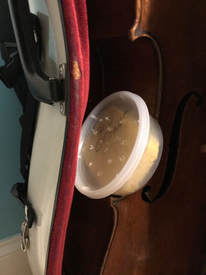
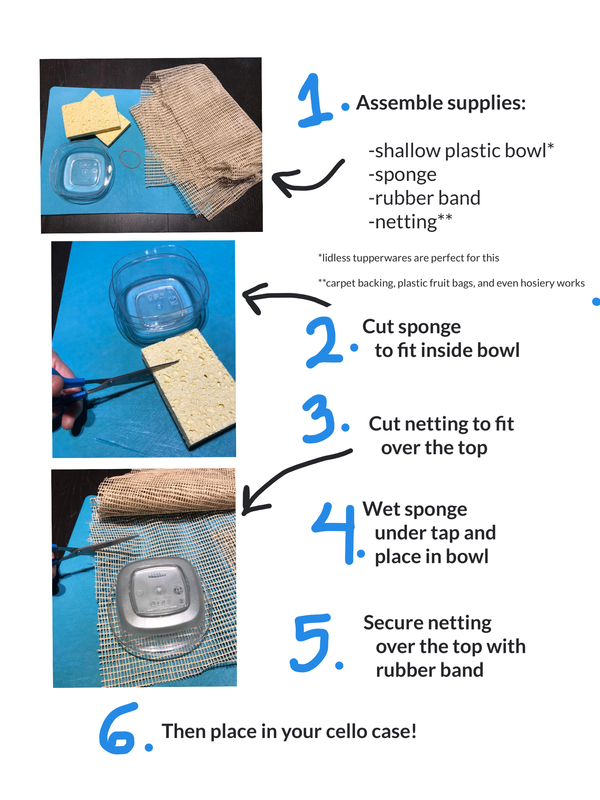
 RSS Feed
RSS Feed